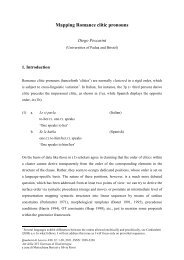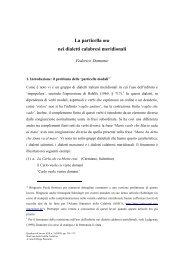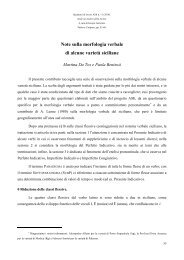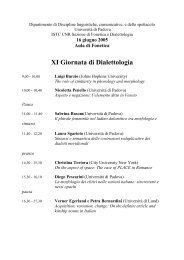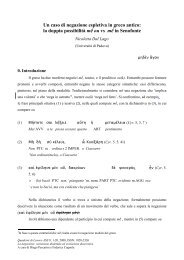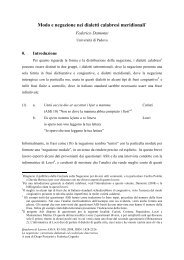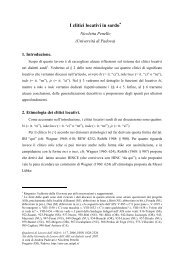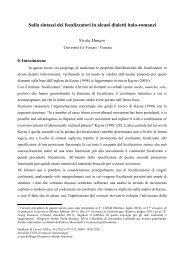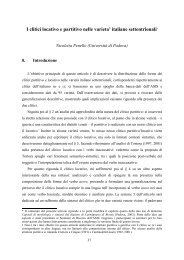Aspetto e negazione: l'elemento 'altro' in veneto - Atlante Sintattico ...
Aspetto e negazione: l'elemento 'altro' in veneto - Atlante Sintattico ...
Aspetto e negazione: l'elemento 'altro' in veneto - Atlante Sintattico ...
You also want an ePaper? Increase the reach of your titles
YUMPU automatically turns print PDFs into web optimized ePapers that Google loves.
IMF Research Bullet<strong>in</strong>6Dismal Employment Growth <strong>in</strong> EU Countries(cont<strong>in</strong>ued from page 5)• Dur<strong>in</strong>g 2008–11 there was a negative relationshipbetween the <strong>in</strong>crease <strong>in</strong> the profit share and GDP growth.Profit shares <strong>in</strong>creased sharply <strong>in</strong> several countries withlarge output decl<strong>in</strong>es, while they decl<strong>in</strong>ed <strong>in</strong> a numberof core euro area countries where output <strong>in</strong>creased. Thissuggests that—for this particular period—causality didnot go from GDP growth to profits, but rather that corporaterestructur<strong>in</strong>g (which boosted corporate profits)had a negative impact on GDP.• Larger profit share <strong>in</strong>creases were also associated withbigger <strong>in</strong>creases <strong>in</strong> labor productivity. The <strong>in</strong>crease <strong>in</strong>productivity likely reflects restructur<strong>in</strong>g by enterprisesto produce the same output with fewer workers. It maypartly also reflect a composition effect, as sectors withlower labor productivity (<strong>in</strong>clud<strong>in</strong>g, <strong>in</strong> particular, theconstruction sector <strong>in</strong> some countries) were hit disproportionallyby the crisis.The comb<strong>in</strong>ation of a sharp <strong>in</strong>crease <strong>in</strong> labor productivitywith a decl<strong>in</strong>e <strong>in</strong> output is very different from thepositive relationship observed dur<strong>in</strong>g normal times.Between 2003 and 2008, faster GDP growth was associatedwith higher labor productivity growth. Between 2008 and2011, this relationship broke down, and labor productivitygrowth was fastest <strong>in</strong> some of the countries with the largestoutput decl<strong>in</strong>es.Labor Market Duality Did Not HelpThere are large differences across European countries <strong>in</strong> theduality of the labor market. In some countries a large shareof employment consists of temporary jobs. In these countriesthere is a stark difference between <strong>in</strong>siders (who have permanentjobs and cannot easily be fired) and outsiders (who havetemporary jobs).We would expect that countries with dual labor marketswill see sharper reductions of employment than other countries.For a given level of output, profit shares can be <strong>in</strong>creasedeither through employment reductions or wage decl<strong>in</strong>es. Incountries with dual labor markets, it is likely that much ofthe adjustment will go through employment reductions ratherthan wage cuts, as <strong>in</strong>siders have little <strong>in</strong>centive to adjustwages, while outsiders can easily be fired. Indeed, we show<strong>in</strong> our paper that <strong>in</strong> countries with a high share of temporaryemployment, real wage growth is much less sensitive tounemployment changes.Figure 2. Decomposition of Employment Growth 2008–11Employment growth (%)151050–5–10–15–20Due to GDP growthDue to share of temporaryworkersEmployment growth 2008–11Econometric AnalysisEconometric regression analysis confirms that the three factorsdiscussed—real GDP growth, corporate balance sheetrepair, and labor market duality—all contributed to the largecross-country differences <strong>in</strong> employment growth dur<strong>in</strong>g2008–11. The results are robust to <strong>in</strong>troduc<strong>in</strong>g other precrisisimbalance measures to the model, such as current accountdeficits and the size of the construction sector.A decomposition exercise illustrates the important roles ofboth the <strong>in</strong>crease <strong>in</strong> corporate profits and labor market duality<strong>in</strong> the large drop <strong>in</strong> employment that occurred <strong>in</strong> a number ofcountries. Figure 2 shows that among all the countries whereemployment dropped by more than 7 percent, with the notableexception of Greece, the <strong>in</strong>crease <strong>in</strong> profits accounted for morethan 50 percent of the job losses. The figure also shows thatlabor market duality contributed over 4 percentage po<strong>in</strong>ts tothe employment losses <strong>in</strong> Spa<strong>in</strong>, Poland, and Portugal.Policy ImplicationsDue to profit share changeDue to other factorsPolandGermanyBelgiumSwedenAustriaFranceUnited K<strong>in</strong>gdomNetherlandsCzech RepublicHungaryItalyF<strong>in</strong>landSlovak RepublicDenmarkSloveniaPortugalEstoniaLithuaniaGreeceSpa<strong>in</strong>LatviaIrelandSources: IMF, World Economic Outlook database; Haver Analytics;and IMF staff estimates.The analysis <strong>in</strong> this paper suggests that the large employmentlosses <strong>in</strong> many countries have been the result of a corporateadjustment process, which helped restore the f<strong>in</strong>ancial healthof the corporate sector. While the adjustment has deepened therecession, it has also helped set the stage for renewed growth.It is difficult to determ<strong>in</strong>e ex ante when the corporateadjustment will have run its course. There are, however, signsthat <strong>in</strong> at least some of the crisis-hit countries, the processmay be near<strong>in</strong>g its end. For <strong>in</strong>stance, <strong>in</strong> Ireland, the profitshare stopped <strong>in</strong>creas<strong>in</strong>g and the wage bill ended its decl<strong>in</strong>e



